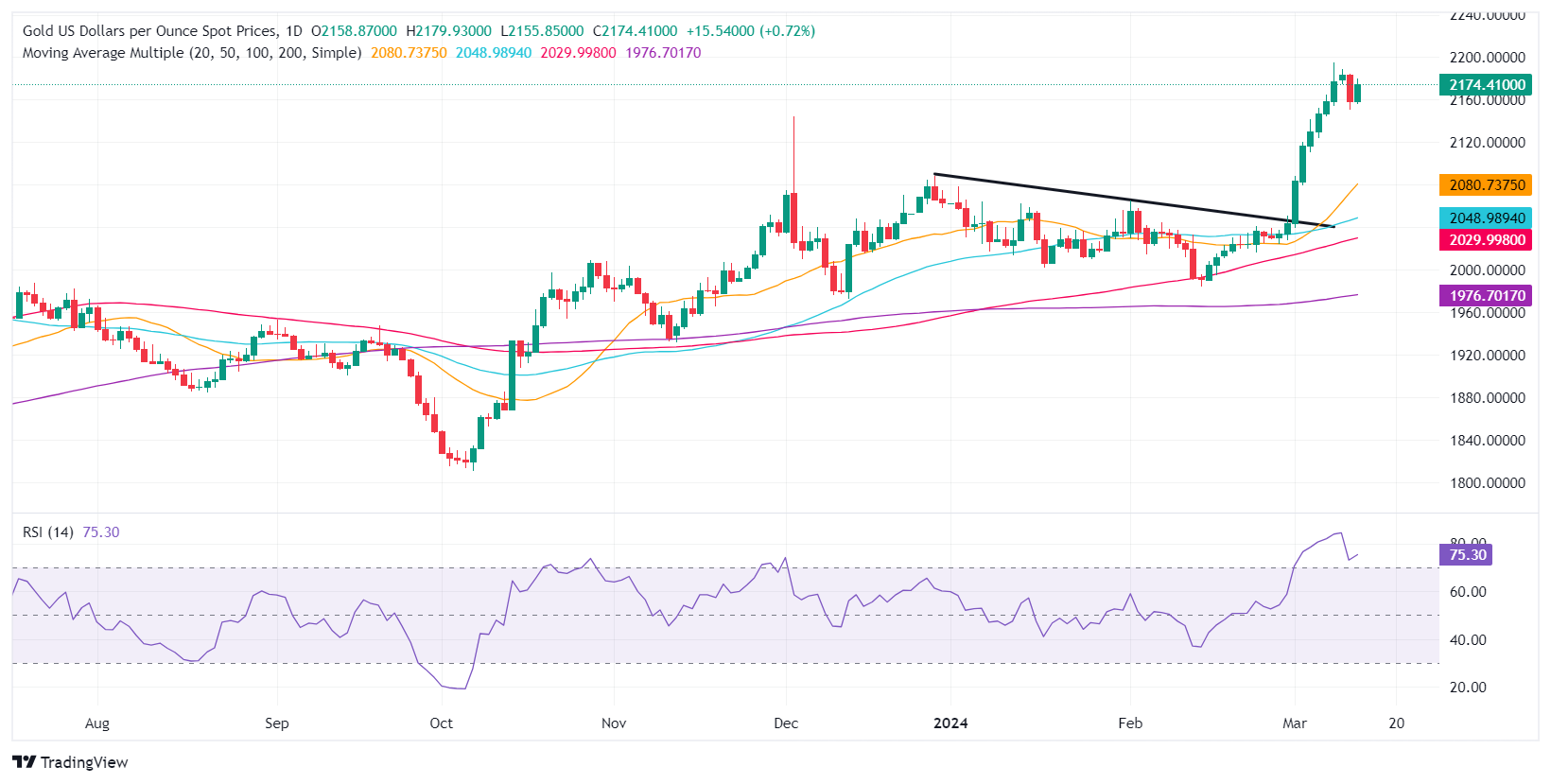Gold’s uptrend remains intact as buyers target $2,200, ahead of US Retail Sales

- Gold recovers, reflecting optimism for potential Fed rate cuts despite a recent surge in inflation.
- US economic resilience and inflation above 3.2% pose challenges to immediate easing of Fed monetary policy.
- Powell’s cautious stance on easing, tied to disinflation evidence, keeps investors on edge as Treasury yields rise.
Gold prices recovered on Wednesday after a pullback to the $2,150.00 region, and traders seem convinced that the US Federal Reserve (Fed) could cut borrowing costs. Nevertheless, the latest hotter-than-expected inflation report in the United States might deter Fed officials from easing policy in June, contradicting market participants’ speculation. Therefore, the XAU/USD trades at $2,173.60, gaining 0.7%.
The latest US economic data suggests the economy remains robust, even though the labor market is cooling. Nevertheless, headline and underlying inflation remaining above 3.2% in the twelve months to February might push back some Fed officials’ intentions to cut borrowing costs.
Last week, US Federal Reserve Chair Jerome Powell said the central bank is ready to ease policy if conditions are met and the disinflation process continues. He emphasized that they are data-dependent, in no rush to begin the trimming cycle, and would like to see more evidence of the evolution of the disinflation process.
In the meantime, the yellow metal stays in the green even though the US 10-year Treasury bond yield rose three-and-a-half basis points from 4.157% to 4.19%.
Daily digest market movers: Gold traders push prices higher, await US Retail Sales data
- On Thursday, further US economic data is eyed with the release of US Retail Sales and the Producer Price Index (PPI). The Producer Price Index (PPI) is foreseen to deliver mixed readings, with core at 1.9% YoY, down from 2%, and headline at 1.1% YoY, up from 0.9%. The next Fed meeting is scheduled for March 19-20 next week.
- The US labor market is cooling down despite printing solid gains in February compared to “downward revised” figures from January. After two months of net revisions, US jobs market totals were reduced by 167,000 jobs compared with initial prints, which sparked a reaction from interest rate futures traders.
- According to the CME FedWatch Tool, expectations for a May rate cut remain low, having dropped to 11% from 22%. However, the odds for June stand at 64%, down from 72%.
- Federal Reserve officials last week expressed that they remain data-dependent and want to feel secure that inflation is sustainably trending toward the Fed’s 2% goal. Tuesday’s inflation report was relevant as it triggered a U-turn in XAU/USD prices.
Technical analysis: Gold aims toward $2,180 amid higher US yields
Gold’s rally continued on Wednesday after Tuesday’s pullback to the $2,150.00 mark. However, buyers must reclaim the March 12 high of $2,184.76, followed by the year-to-date high of $2,195.15, if they would like to challenge $2,200.00. Further upside is seen after a breach of the latter, with prices standing in uncharted territory.
On the flip side, XAU/USD sellers need to drag prices below $2,150.00, which could exacerbate a fall toward the March 6 low of $2,123.80. Further support is seen at $2,100.00, ahead of the December 28 high at $2,088.48 and the February 1 high at $2,065.60.
Gold FAQs
Gold has played a key role in human’s history as it has been widely used as a store of value and medium of exchange. Currently, apart from its shine and usage for jewelry, the precious metal is widely seen as a safe-haven asset, meaning that it is considered a good investment during turbulent times. Gold is also widely seen as a hedge against inflation and against depreciating currencies as it doesn’t rely on any specific issuer or government.
Central banks are the biggest Gold holders. In their aim to support their currencies in turbulent times, central banks tend to diversify their reserves and buy Gold to improve the perceived strength of the economy and the currency. High Gold reserves can be a source of trust for a country’s solvency. Central banks added 1,136 tonnes of Gold worth around $70 billion to their reserves in 2022, according to data from the World Gold Council. This is the highest yearly purchase since records began. Central banks from emerging economies such as China, India and Turkey are quickly increasing their Gold reserves.
Gold has an inverse correlation with the US Dollar and US Treasuries, which are both major reserve and safe-haven assets. When the Dollar depreciates, Gold tends to rise, enabling investors and central banks to diversify their assets in turbulent times. Gold is also inversely correlated with risk assets. A rally in the stock market tends to weaken Gold price, while sell-offs in riskier markets tend to favor the precious metal.
The price can move due to a wide range of factors. Geopolitical instability or fears of a deep recession can quickly make Gold price escalate due to its safe-haven status. As a yield-less asset, Gold tends to rise with lower interest rates, while higher cost of money usually weighs down on the yellow metal. Still, most moves depend on how the US Dollar (USD) behaves as the asset is priced in dollars (XAU/USD). A strong Dollar tends to keep the price of Gold controlled, whereas a weaker Dollar is likely to push Gold prices up.
